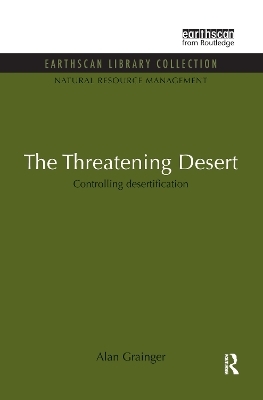
The Threatening Desert
Earthscan Ltd (Verlag)
978-1-84971-014-5 (ISBN)
Lands lost to desert may effectively be lost for ever, so desertification is humanity's most obvious despoliation to the planet. It is certainly one of the most serious environmental problems facing the world today. In this book the author describes what is happening and where. Although the problem is greatest in developing countries, it is by no means confined to them. Australia, Africa, the USA and India are all affected. In the 1970s an international Plan of Action was drawn up to bring the phenomenon under control, but it was never implemented. Now that the situation is more serious than ever before, this book urges new action and describes many of the myriad ways in which it is possible to arrest the progress of desertification. It describes, too, not just the failures, but the considerable successes that have been achieved.
Originally published in 1990
Alan Grainger
Figures and Tables
Acronyms
Preface
Introduction
1. What Is Desertification?
Desertification Defined
The Distribution of Drylands
The Arid Zones
Natural Deserts and Desertification
The Two Main Characteristics of Desertification
The Direct and Indirect Causes of Desertification
Desertification and Civilization
Drought and Desertification
Questions Remain about Desertification
A Complex Phenomenon
2. The Causes of Desertification
Overcultivation
Overgrazing
Poor Irrigation Management
Deforestation
Causes and Solutions
3. Desertification, People and Policy
Population Growth
Economic Development
Desertification and Underdevelopment
The Role of Government
Famine, Poverty and Desertification
Desertification in Developed Nations
A Broader Perspective
4. The Scale of Desertification
The Regional Distribution of Desertification
Estimates of the Extent and Rate of Desertification
Developing a New System of Desertification
Indicators
Using Remote Sensing to Improve the Monitoring of Desertification
The Data Imperative
5. Controlling Desertification by Improving Crop Production
Improving Rainfed Cropping
Improving Irrigated Cropping
The Role of Cropping in Desertification Control
6. Controlling Desertification by Improving Livestock Raising
Improving Animal Quality
Reducing Stock Levels
Improving Rangelands
More Wells?
Regulating Nomads
The Prospects for Livestock Development
Pastoral Associations: the Last Hope?
The Livestock Dilemma
7. Controlling Desertification by Planting Trees
The Fuelwood Crisis
Large-scale Fuelwood Plantations
Social Forestry
Does Community Forestry have a Future?
The Role of Non-governmental Organizations
Improved Stoves
Future Tree-planting Strategies
8. Farm Forestry and Natural Woodland Management
Farm Forestry
Agroforestry
Managing Natural Woodlands
The Potential of Agroforestry and Natural Woodland Management
9. Turning the Tide
Progress in Soil Conservation
Preventing Sand Dune Encroachment
The Prospects for Soil Conservation and Desert Reclamation
10.Controlling Desertification: Progress and Prospects
Progress so Far
Constraints on Progress
Success or Failure?
Priorities for Action
Conclusions
Appendix: Summary of the UNCOD Plan of Action to Combat Desertification
Bibliography
Index
| Erscheint lt. Verlag | 1.10.2009 |
|---|---|
| Reihe/Serie | Natural Resource Management Set |
| Verlagsort | London |
| Sprache | englisch |
| Maße | 156 x 234 mm |
| Gewicht | 748 g |
| Themenwelt | Naturwissenschaften ► Biologie ► Ökologie / Naturschutz |
| Technik ► Umwelttechnik / Biotechnologie | |
| ISBN-10 | 1-84971-014-7 / 1849710147 |
| ISBN-13 | 978-1-84971-014-5 / 9781849710145 |
| Zustand | Neuware |
| Haben Sie eine Frage zum Produkt? |
aus dem Bereich


